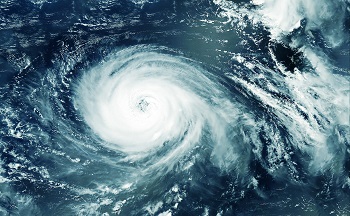Global Warming’s Dual Extremes: More Wildfires and Heavier Rain
- Social Issues & Advancing Society
- Insurance & Risk Insights
-
*This is a reprint of an article in SENSOR, the newsletter published by the Tokio Marine Research Institute.
This year, a series of large-scale forest fires have already caused tremendous damage across Japan. Due to increased global warming, the air is becoming drier, raising the likelihood of fires. At the same time, heavy rains are also predicted to increase. These phenomena may appear contradictory, but both are linked to fluctuations in atmospheric water vapor caused by rising temperatures. It this article, I will elucidate how it is possible to simultaneously have more rain and more fires.
1. Are forest fires on the rise?
In Japan, the number of forest fires has been decreasing when viewed over a medium- to long-term span (Figure 1). The main causes of forest fires are human activities such as campfires, the controlled burning of forests, and arson . During the Showa era (1926–1989), forestry was more prevalent as an industry in Japan. Mountain areas had more foot traffic, which likely contributed to a higher incidence of forest fires than we see today.
Recently, around 1,000 forest fires occur each year.
(Source: Forestry Agency website: Forest Fire Prevention!!)
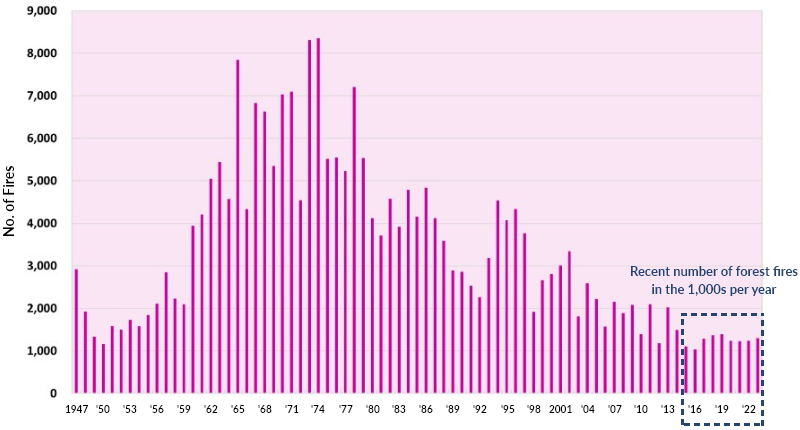
2. How do large-scale forest fires occur?
Weather conditions are believed to have played a significant role. Precipitation from December 2024 to February 2025 was below normal*3 nationwide, except for the western (Japan Sea) side of the Hokuriku region and northward (Figure 2). As a result, the soil and vegetation in forests lacked moisture, causing the ground surface to become extremely dry and highly susceptible to the spread of fires. This was the case in Ofunato (Figure 3), where precipitation had been significantly below normal in the months before the large-scale forest fires broke out (Figure 3). For this reason, we may assume the amount of water absorbed by the forest soil and vegetation decreased, leaving the ground surface extremely dry.
(Source: Japan Meteorological Agency (JMA) website: Winter Weather from 2024 to 2025 (Dec–Feb)

Figure 4 shows the difference between the relative humidity (an indicator of the degree of atmospheric dryness) at an altitude of approximately 750m (925hPa) in February 2025 and the average value for the reference period (1991–2020). The red area indicates that relative humidity was lower than normal, meaning the air was drier. Arrows indicate in which direction the wind was blowing stronger than average.
February 2025 saw stronger westerly winds than usual, so the air colliding with the Ou Mountains brought snow and rain to the Sea of Japan side, while dry air flowed to the Pacific side. This effect led to the air being particularly dry in the Sanriku coastal area around Ofunato City. The combined effects depicted in both figures below created weather conditions conducive to forest fires.
(Compiled by Tokio Marine Research Institute (TMRI) based on observation data from the JMA)
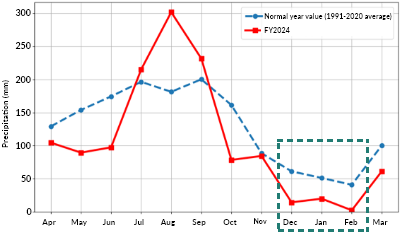
(Compiled by Tokio TMRI based on the European Centre for Medium-Range Weather Forecasts (ECMWF)'s Reanalysis v5 (ERA5) dataset)

3. Will forest fires become more frequent due to global warming?
As global warming progresses, atmospheric temperatures rise, causing, the total amount of water vapor that the air can retain (saturated water vapor amount) to increase*4. At first, you might think that if the amount of water vapor in the air increases the air shouldn’t dry out as easily. However, in reality, water vapor does not increase uniformly. Its accumulation varies depending on the region and season, leading to uneven increases. As a consequence, as global warming progresses, the gap between places that become drier and places that experience more heavy rainfall will widen.
The key indicator here is relative humidity: the ratio of the actual amount of water vapor contained in the air to the maximum amount of water vapor that air can hold at that temperature. When the actual amount of water vapor is less than the total amount of water vapor that can be retained, the air is considered to be dry.
(Places where water vapor tends not to accumulate)
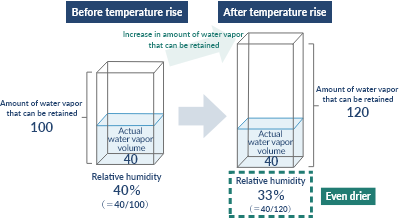
(Places where water vapor tends to accumulate)
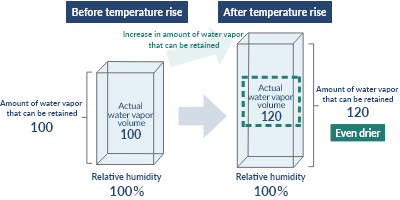
Therefore, in places where the temperature rises but the supply of water vapor cannot keep up (where moist air cannot flow in easily), the maximum amount of water vapor that can be retained increases, but the actual amount of water vapor does not, so relative humidity decreases (Figure 5-1). This drier air intensifies the risk of forest fires, making it easier for even small fires to spread and cause damage.
On the other hand, in places where water vapor easily accumulates (where moist air tends to flow in), when the temperature rises, not only does the amount of water vapor that can be retained increase, but the actual water vapor volume contained in the air also tends to increase (Figure 5-2). When the amount of water vapor increases to the limit at which air can retain it (relative humidity of 100%), the water vapor eventually falls as rain. The greater the actual water vapor volume, the greater the amount of rainfall is likely to be. In this way, the increase in water vapor in the air accompanying rising temperatures is thought to be one of the factors contributing to the occurrence of extreme heavy rainfall, such as in linear rainbands.
This phenomenon is mentioned in the report "Climate Change in Japan 2025,"*5 which summarizes the results of global warming observations and future predictions compiled by the Ministry of Education, Culture, Sports, Science and Technology and the JMA. The same report predicts that as global warming progresses, the frequency and intensity of heavy rainfall will increase, while the number of days with less than 1.0mm of precipitation, known as "no precipitation days," will also increase.
The annual average temperature in Japan has risen by about 1.40°C in the last 100 years. We believe the state of water vapor in the air is already being affected. Since there is no observational data for Ofunato prior to 1962, consider data from Miyako City, which is nearby. Comparing a 30-year period 100 years ago (1895–1924) with the most recent 30-year period (1995–2024), the average annual temperature in Miyako has risen by approximately 0.96°C*6. Figure 6 outlines the changes in relative humidity during this period.
In January and February in particular, relative humidity fell by almost 10%. This change is likely to be largely due to the rise in temperature.
While we cannot state definitively the relationship between rising temperatures and the forest fires in Ofunato, we are already seeing objective changes in atmospheric conditions.
(versus 100 years ago) (Compiled by TMRI based on observation data from the JMA)
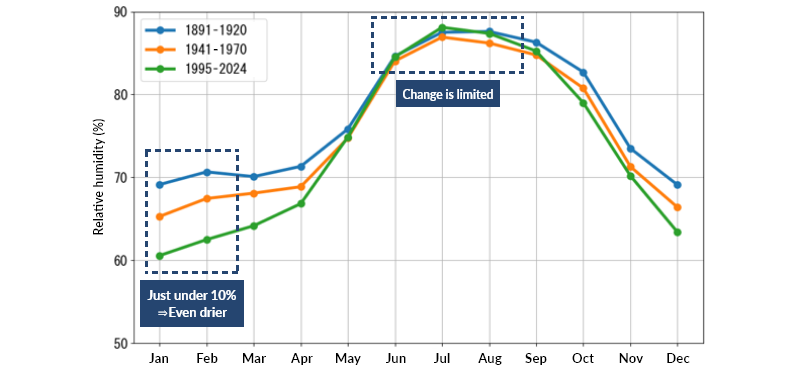
4. In closing
Global warming causes two seemingly contradictory phenomena: low humidity and heavy rainfall. Both cases are mainly caused by an increase in the amount of water vapor that the atmosphere can retain (saturated water vapor) as temperatures rise. In other words, climate polarization is expected to continue, with some areas becoming drier and more prone to wildfires, while others experience more severe torrential rains.
Global warming is not just about rising temperatures. Understanding the bigger picture of how extreme weather events can become even more extreme is the first step in preparing for disasters.
Author's comments
In recent years, large-scale forest fires have occurred frequently both in Japan and abroad, and have been widely reported in the news. Many people probably feel that rising temperatures caused by global warming and dry air and soil are factors contributing to these fires.
Forests play a role in absorbing carbon dioxide and mitigating global warming, but once lost to fire, it takes a long time for them to rejuvenate. Not only will carbon sinks decrease, but the fires will discharge large amounts of carbon dioxide, which may further accelerate global warming.
On the other hand, it is said that as global warming progresses, there will be an increase in the torrential rains that have been seen in various places in recent years. Why do the seemingly contradictory phenomena of dryness and heavy rainfall occur simultaneously as temperatures rise?
This article focuses on the relationship between temperature and water vapor volume and explores the reasons behind it. I hope that understanding the mechanisms behind these weather phenomena will provide insights for preparing for climate change and disasters.
THE TOKIO MARINE RESEARCH INSTITUTE Research Officer Takao Araki

-
*1
-
*2
-
*3Average value for 30 years from 1991 to 2020
-
*4According to the Clausius-Clapeyron theorem, a 1°C increase in temperature increases saturated water vapor by approximately 7%.
-
*5
-
*6Comparison of average annual average temperature for 30 years from 1895–1924 and 1995–2024
-
*Reference links only available in Japanese
